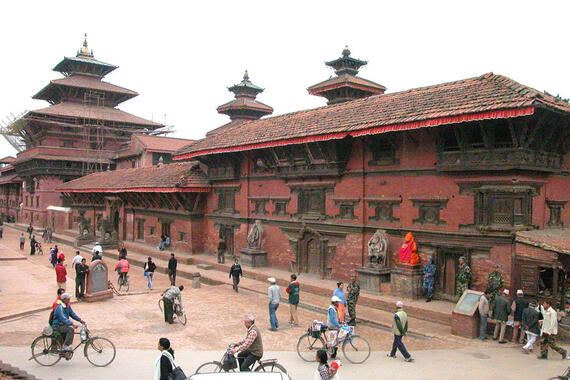Seismic Strengthening Saves Sundari Cok

World Monuments Fund helped Kathmandu Valley Preservation Trust to produce a multiphase preservation plan for the Patan Royal Palace Complex a few years back. The buildings and monuments in the complex that we had helped to restore withstood the test of the devastating earthquake on April 25, 2015, better than expected. We asked Liz Newman, Architect for KVPT, to tell us about the work that was done that helped to save these treasured buildings.
Kathmandu Valley Preservation Trust has always included seismic strengthening in our projects, and it is one of the trickiest parts of our work. Finding unobtrusive, reversible techniques that fit the unique construction types we work with is only the start. Projects also have to be approved by a very conservative government agency; materials are scarce; materials quality issues come up constantly; and construction is low-tech; so we have to plan around those realities.
Here’s an example from the Sundari Cok, considered the palace’s most beautiful courtyard building. We did a study of the building itself and studied old photos from the major collapse of Sundari Cok after the 1934 earthquake to understand the existing conditions, including seismic strengths and weaknesses. Our starting strategy also came from our experience with other buildings and from the ICOMOS Charter of Venice, which states that “where traditional techniques prove inadequate, the consolidation of a monument can be achieved by the use of any modern techniques for conservation and construction, the efficacy of which has been shown by scientific data and proved by experience.” Since large parts of Sundari Cok had collapsed in 1934 and were not reinforced when they were rebuilt, the building had major weaknesses. It had also deteriorated over time due to lack of maintenance, which lead, for example, to water damage from roof leaks, rotting the ends of the timbers embedded in the masonry walls. The worst area was at the garden wall of the east wing, which had collapsed almost completely in the last earthquake and was poorly rebuilt in a completely different style; but the whole thing was vulnerable.
We designed techniques to sensitively address many of the building’s seismic weaknesses. To stabilize the heavy mud and tile roofs and floors, diaphragms were made out of a double layer of plywood between the ceiling planks and the mud setting beds above and anchored to the adjacent structure. The timbers of the overhanging balconies were tied back to the rafters and to the floor joists with stainless steel pins, and the same was done with many other timber connections-at the roof ridge and between floor plates, columns, and cross beams. At the foundations, solid brick walls with traditional mud mortar replaced the mud that was packed between the inner and outer walls. All of these techniques were designed to help the building to move more as one in an earthquake.
When the 2015 earthquake hit, these strategies worked well; only the still-unrestored east wing was damaged. With its new seismic reinforcing, the rest of Sundari Cok stood strong. The same held for our other past projects, with only three out of nearly 50 suffering any serious damage.
